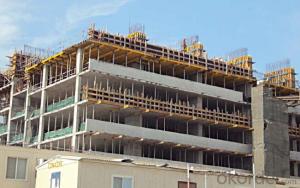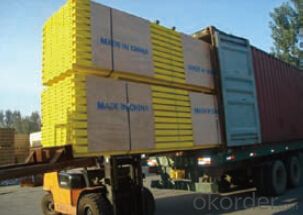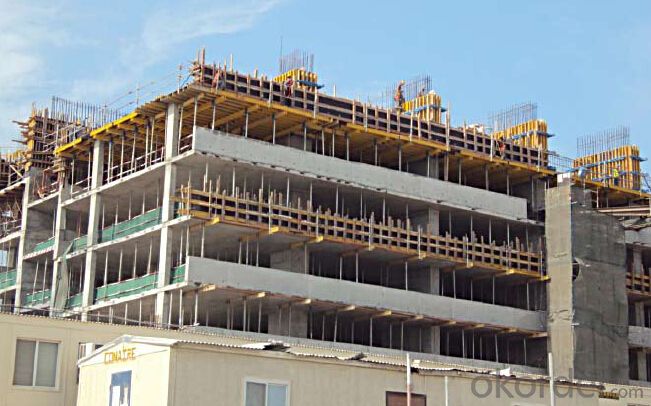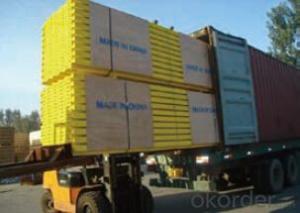Timber Beam Formwork and H20 for Formwork and scaffolding system
- Loading Port:
- Tianjin
- Payment Terms:
- TT OR LC
- Min Order Qty:
- 50 m²
- Supply Capability:
- 1000 m²/month
OKorder Service Pledge
OKorder Financial Service
You Might Also Like
Characteristics:
◆ Standardized production lines.
Supply capability: 3000m/day, Lmax = 6600mm.
◆ Finger jointing of the flange and web, the strength of timber beam is highly improved.
Max. shearing force failure load:40KN
◆ Well treated to prevent from water penetration or erosion, so the service life maximally
extended.
Normally, CNBM timber beam H20 can be used for 4 to 5 years, the exact using time would
depend on maintenance & storage.
◆ Robust caps at the end of the girders protect against damages.
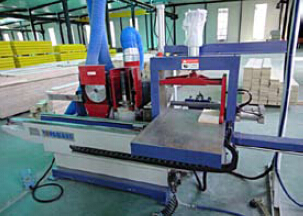
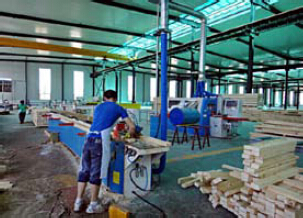

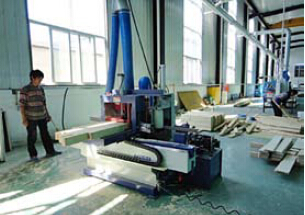
- Q: What are the considerations when selecting the size and spacing of steel formwork panels?
- When selecting the size and spacing of steel formwork panels, there are several important considerations to take into account. Firstly, the size of the panels should be determined based on the specific requirements of the project. Factors such as the dimensions and shape of the concrete structure being formed, as well as the load-bearing capacity of the panels, need to be considered. It is crucial to choose panel sizes that can adequately support the weight of the concrete and any additional loads during the construction process. The spacing of the steel formwork panels is another important consideration. The spacing should be determined based on the desired concrete thickness and the ability of the panels to resist any deflection or bending under the weight of the concrete. The spacing should be close enough to prevent any excessive sagging or bulging of the panels, which could result in an uneven concrete surface. Additionally, the spacing should also allow for easy installation, removal, and handling of the formwork panels. This is particularly important for efficient and cost-effective construction processes. Adequate spacing between panels will allow for smooth and safe placement and removal of the formwork, reducing the risk of accidents or delays. Furthermore, the spacing should also take into account the size and accessibility requirements for construction equipment and workers. Sufficient space between the panels will allow for the movement and operation of equipment, such as cranes or concrete pumps, and ensure that workers can access the formwork to complete their tasks safely and efficiently. Overall, the size and spacing of steel formwork panels should be carefully considered to ensure the structural integrity of the concrete structure being formed, as well as the safety and efficiency of the construction process. It is important to consult with experienced professionals or engineers to determine the most suitable panel sizes and spacing for each specific project.
- Q: Can steel formwork be used for concrete structures in corrosive environments?
- No, steel formwork should not be used for concrete structures in corrosive environments as it may lead to corrosion of the steel and compromise the integrity of the structure.
- Q: How does steel formwork accommodate for different concrete curing temperatures?
- Accommodating various concrete curing temperatures is easily achieved with steel formwork, thanks to its versatility and reliability. The standout characteristic of steel formwork is its exceptional thermal conductivity, which effectively dissipates heat from curing concrete. This unique property enables the steel formwork to effectively regulate the concrete's temperature during the curing process. When precise control over the concrete curing temperature is necessary, steel formwork can be equipped with additional features to meet these requirements. For example, insulation materials can be applied to the steel formwork to minimize heat loss or gain, ensuring a consistent and steady curing temperature. This adaptation proves especially beneficial in extreme weather conditions when the ambient temperature can have a significant impact on the curing process. Furthermore, steel formwork can be combined with heating or cooling systems to further regulate the concrete curing temperature. In colder weather conditions, heating elements can be integrated into the steel formwork to maintain an optimal temperature for proper curing. Similarly, in hotter weather conditions, cooling systems can be employed to prevent excessive heat from affecting the curing process. In addition to its temperature control capabilities, steel formwork boasts exceptional strength and durability, making it an ideal choice for accommodating various concrete curing temperatures. The robust nature of steel formwork allows it to withstand the pressure and stresses exerted by the curing concrete, regardless of the temperature. This ensures that the formwork remains intact and stable throughout the curing process, preventing any deformations or failures that could compromise the quality of the concrete structure. Overall, steel formwork offers a comprehensive solution for accommodating different concrete curing temperatures. Its high thermal conductivity, compatibility with insulation materials, and integration with heating or cooling systems make it a versatile option. Additionally, its strength and durability guarantee its ability to withstand the challenges posed by varying curing temperatures, ensuring successful and optimal concrete curing.
- Q: How does steel formwork accommodate for different concrete curing methods?
- Due to its durability, flexibility, and ease of use, steel formwork is a versatile construction material that can accommodate various concrete curing methods. To begin with, different curing methods can be employed with steel formwork, including wet curing, dry curing, and accelerated curing. Wet curing involves maintaining the concrete's moisture and hydration for a specific period, while dry curing involves controlling the concrete's environment with low humidity. On the other hand, accelerated curing utilizes external heat sources to expedite the curing process. Steel formwork is particularly suitable for wet curing as it effectively retains moisture and prevents water loss from the concrete. The tightly fitted steel panels create a watertight enclosure that minimizes evaporation. This ensures that the concrete remains adequately hydrated during curing, promoting proper strength development and minimizing the risk of cracking or shrinkage. Likewise, steel formwork easily accommodates dry curing methods. The steel panels act as a barrier between the concrete and the surrounding environment, allowing precise control of humidity levels. This is especially beneficial in hot or dry climates, where maintaining a low humidity environment is critical for preventing premature moisture loss and ensuring proper curing. Furthermore, steel formwork is compatible with accelerated curing techniques. Its ability to withstand high temperatures makes it suitable for applications where external heat sources are used to expedite the curing process. The steel panels can withstand elevated temperatures without warping or compromising their structural integrity. Additionally, steel formwork can be easily adjusted or modified to meet specific curing requirements. The modular nature of steel formwork allows for flexibility in design and construction. By rearranging or adding steel panels, the formwork can be customized to create different shapes, sizes, or configurations. This flexibility is particularly advantageous when dealing with complex or unique concrete structures. In summary, steel formwork is a reliable choice for accommodating various concrete curing methods. Its durability, flexibility, and adaptability make it the preferred option in construction projects that require precise control over the curing process to achieve optimal concrete strength and quality.
- Q: How does steel formwork contribute to the overall fire safety of the building?
- Steel formwork contributes to the overall fire safety of the building in several ways. Firstly, steel is a non-combustible material, meaning it does not burn or contribute to the spread of fire. This helps to minimize the risk of fire spread and containment breaches within the structure. Additionally, steel formwork provides structural stability and strength, which is crucial during a fire event as it helps to maintain the integrity of the building and prevents structural collapse. Steel also has a high melting point, allowing it to withstand high temperatures for longer periods before it weakens, providing additional time for evacuation and firefighting efforts. Overall, the use of steel formwork enhances the fire resistance of the building, ensuring the safety of occupants and minimizing potential damage.
- Q: Can steel formwork be used for both straight and sloping structures?
- Yes, steel formwork can be used for both straight and sloping structures. Steel formwork is highly versatile and can be easily adjusted to accommodate various angles and curves, making it suitable for constructing both straight and sloping structures efficiently and effectively.
- Q: Can steel formwork be used for architectural concrete slabs?
- Yes, steel formwork can be used for architectural concrete slabs. Steel formwork offers several advantages in terms of strength, durability, and versatility compared to other types of formwork materials. It provides a rigid structure that can withstand the pressure of fresh concrete, ensuring accurate and precise placement of the slabs. Additionally, steel formwork can be easily reused multiple times, making it cost-effective and environmentally friendly. Its smooth surface also results in a high-quality finish for architectural concrete slabs. However, it is essential to ensure proper insulation and release agents are used to prevent the steel from transferring heat or causing concrete adherence issues. Overall, steel formwork is a reliable and efficient choice for creating architectural concrete slabs.
- Q: How does steel formwork handle different concrete curing temperatures?
- Steel formwork is an incredibly durable and flexible construction material that is ideal for managing various concrete curing temperatures. Its main advantage lies in its ability to endure high temperatures without warping or causing structural damage. The concrete curing temperature can differ based on numerous factors, such as the weather, project requirements, and construction timetable. Steel formwork is specifically designed to withstand these differences and maintain its structural integrity throughout the curing process. When the concrete curing temperature is high, steel formwork effectively disperses the heat thanks to its exceptional thermal conductivity. This prevents excessive heat accumulation, which could lead to premature curing or thermal cracking of the concrete. The steel formwork acts as a heat absorber, evenly absorbing and distributing the heat to ensure consistent curing throughout the concrete structure. On the other hand, steel formwork also performs well in low-temperature curing conditions. Its high tensile strength and rigidity allow it to withstand the pressure exerted by the cold concrete mixture during curing. This prevents any distortion or warping of the formwork, ensuring precise shaping of the concrete structure. Furthermore, steel formwork is resistant to moisture and humidity, which are crucial factors in concrete curing. It does not absorb water or release moisture, maintaining a steady moisture content in the concrete during the curing process. This is particularly advantageous in areas with high humidity or when the curing time is prolonged. In conclusion, steel formwork is a dependable and sturdy material that can effectively handle various concrete curing temperatures. Its ability to disperse heat, endure cold temperatures, and resist moisture makes it the preferred choice for construction projects where temperature variations are a concern.
- Q: How does steel formwork contribute to the overall quality of the concrete finish?
- Steel formwork contributes to the overall quality of the concrete finish in several ways. Firstly, steel formwork provides a strong and rigid framework for the concrete to be poured into. This ensures that the concrete is poured in the desired shape and dimensions, resulting in a more accurate and precise finish. Unlike other types of formwork materials, such as wood or plastic, steel formwork does not warp or bend under the weight and pressure of the concrete. This prevents any deformations or imperfections in the final concrete surface. Secondly, steel formwork allows for smoother and more even concrete surfaces. The smooth surface of steel formwork prevents the formation of air pockets or voids in the concrete, resulting in a smoother finish. This is particularly important for concrete surfaces that will be exposed or visible, such as architectural elements or decorative finishes. Furthermore, steel formwork provides better support and stability during the pouring and setting process of the concrete. The rigid structure of steel formwork ensures that the concrete is properly contained and supported, reducing the risk of cracks or other structural issues. This helps to maintain the integrity and durability of the concrete finish over time. Additionally, steel formwork is highly durable and reusable. Unlike other types of formwork materials that may need to be replaced after a few uses, steel formwork can be used multiple times without compromising its quality. This not only reduces costs but also ensures consistent and high-quality concrete finishes throughout various construction projects. In conclusion, steel formwork plays a crucial role in achieving a high-quality concrete finish. Its strength, stability, and smooth surface contribute to the accuracy, precision, and durability of the final concrete surface. By providing a reliable and reusable framework, steel formwork helps to create consistent and aesthetically pleasing concrete finishes.
- Q: How does steel formwork compare to timber formwork in terms of cost?
- Steel formwork generally tends to be more expensive than timber formwork. The initial cost of steel formwork is higher due to the higher material and manufacturing costs. However, steel formwork offers durability and reusability, resulting in lower long-term costs as it can be used for multiple construction projects. On the other hand, timber formwork is cheaper initially but requires more frequent replacements and repairs, increasing the overall cost in the long run.
Send your message to us
Timber Beam Formwork and H20 for Formwork and scaffolding system
- Loading Port:
- Tianjin
- Payment Terms:
- TT OR LC
- Min Order Qty:
- 50 m²
- Supply Capability:
- 1000 m²/month
OKorder Service Pledge
OKorder Financial Service
Similar products
Hot products
Hot Searches
Related keywords

